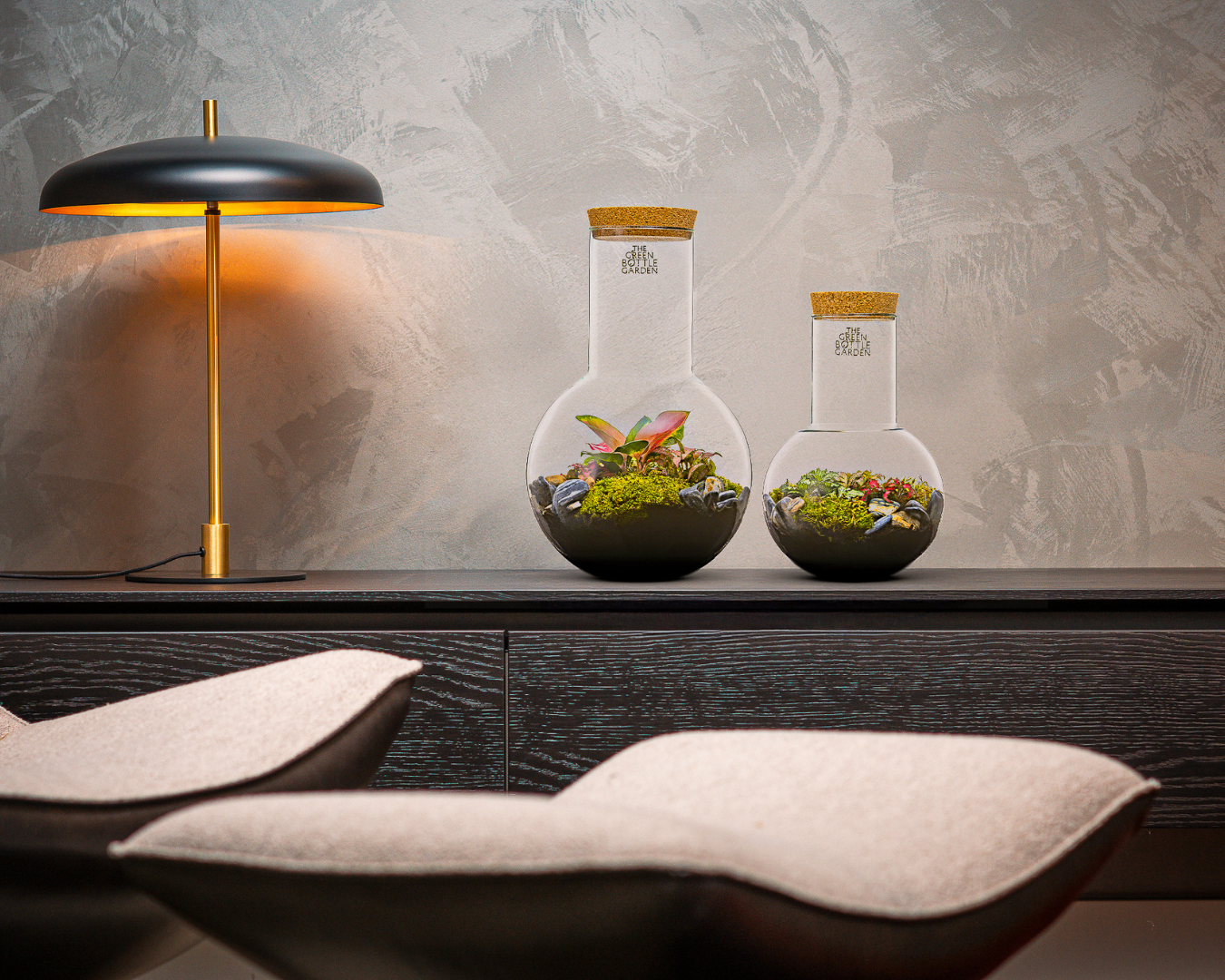Problems in a closed terrarium: Mold, flies or dying plants?
How They Arise – and What You Can Do About Them
A closed terrarium or ecosystem is a beautiful piece of nature in a sealed glass vase. Everything lives in balance: plants, moss, and microorganisms work harmoniously together in a self-sufficient system. At least, most of the time.
Sometimes, however, problems arise: mold growth, tiny flies, or plants that droop—or even die. How do these problems actually arise? How do these creatures get in? And more importantly: how do you solve them without disrupting the delicate balance of your ecosystem?
Understand your ecosystem
A terrarium is a living system with real plants and mosses. No matter how carefully you create it, it's still nature—and nature can't always be controlled. Small disruptions can lead to undesirable symptoms. Fortunately, many of these problems are easy to understand and solve.
How do mold and flies get into a closed ecosystem?
Although an ecosystem is closed, everything starts at the beginning: the materials we Use. Soil, plants, pebbles, and wood almost always contain microscopic fungal spores, bacteria, and sometimes even fly eggs. While we do our best to use the best soil, plants, pebbles, and wood, it can happen. As soon as you close the system, these invisible hitchhikers create a warm, moist environment. Space. ideal place to develop.
The four main causes and what to do about them.
-
- Damp substrate: Soil that is too wet can accelerate mold growth. Make sure you don't put the cork on until the date indicated on the tag.
- Rotting material: Dying leaves or twigs can attract mold and small flies, but they also provide food for your plants. If you see this happening more quickly, remove the rotting leaves from your terrarium.
- Air circulation: Humidity can become extremely high in a sealed container, which encourages mold growth. Remove mold if you see it.
- Unintentionally brought eggs: Some flies lay eggs in potting soil that hatch later. Let the soil dry out a bit and then remove the cork for a few more days.
Three Types of Problems You May Encounter
- Mold: White, fluffy spots on soil, plants, or decorative materials.
- Fungus gnats: Small black flies that often live near the soil. Their larvae can damage roots.
- Fruit flies: Especially when fruits or sugary juices are present.
Why do my plants die in a closed ecosystem?
Unfortunately, a closed ecosystem doesn't always guarantee the survival of every plant. There are several reasons why plants can struggle or even die:
- Too much water: If there's no proper balance between evaporation and condensation, roots remain constantly wet. This causes root rot, a silent killer of plants.
- Solution: Remove the cork for a few more days.
- Too little or too much light: Too little light prevents plants from growing well. Too much direct sunlight can create a greenhouse effect, burning or drying out plants.
- Solution: Make sure your terrarium gets plenty of light. A little sunlight isn't necessarily a problem. Avoid intense midday sun.
- Food shortage: In a closed ecosystem, there's little fresh nutrient supply. Some plants are weaker than others. This can be due to factors that occurred during the growing process, or because the ecosystem was too cold or too warm at one point. Over time, they become exhausted, and/or another plant draws all the nutrients from the others.
- Solution: Let the process continue. If it gets too bad, remove the dead plant from your ecosystem and replace it with a new one.
- Competition and overgrowth: In small spaces, plants can overgrow each other. Some varieties grow faster than others, taking up all the space and light.
- Solution: Prune your overgrown plants. Not too much; a little is enough.
How do you combat mold on and in the soil and flies in plant soil?
Fortunately, there are ways to control problems without disrupting the ecosystem:
Five Ways to Fight the Mold
- Air the pot temporarily: Leave the pot open for a day to lower the humidity.
- Remove affected parts: Cut away moldy plant parts with clean scissors.
- Use activated charcoal: Sprinkle a small amount of finely ground activated charcoal over the mold spots. This helps dry out the mold and prevents further spread.
- Use cinnamon: Sprinkle a small amount of cinnamon over the mold spots. This helps dry out the mold and prevents further spread.
- Avoid overwatering: Make sure the substrate isn't soaking wet. Less water = less chance of mold.
Combating flies in soil
1. Cork the ecosystem: Remove the cork from your ecosystem for a few days first. This is because it's possible there are only a few flies.
2. Deter them: Sprinkle a little cinnamon on the soil. Adult flies can't tolerate this and will flee the bottle.
3. Catch adult flies: Use a small bowl filled with a mixture of water and a few drops of organic dish soap. The flies will be attracted, land on the surface of the water, and drown.
4. Let the topsoil dry out: Fungus gnat larvae live in moist soil. A dry topsoil disrupts their life cycle.
5. Introduce natural enemies: As a last resort, consider introducing nematodes to eat the larvae. While you may continue to see these in your terrarium, they're not always appealing.
Any mold that's even slightly visible should be removed immediately if you want to keep your ecosystem beautiful and healthy. A single fly in the soil isn't harmful and doesn't have to be a disaster; it's part of the natural process within an ecosystem. As long as you keep observing carefully, are willing to make small adjustments, and understand what your plants need, your ecosystem will remain healthy and beautiful.

Share:
Succulents and Cacti in Full Sun: Care & Tips
Open Terrarium Watering | Tips for Healthy Plants